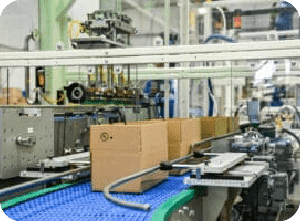When most executives think about optimizing a food packaging line, their attention often gravitates toward high-speed fillers, advanced sealing equipment, or flashy robotics. But there’s a quiet workhorse at the heart of your end-of-line performance: your conveyor system.
Smart conveyor design in food packaging doesn’t just move products—it drives throughput, reduces labor costs, and ensures compliance with stringent food safety standards like FSMA and EHEDG. A poorly planned conveyor layout at the end of your line can create hidden bottlenecks, disrupt product flow, and ultimately erode margins. Conversely, a well-designed system streamlines everything from product accumulation to final case packing, improving efficiency and reducing downtime.
In this article, we’ll show you how to turn conveyor design from an afterthought into a strategic advantage. You’ll learn which conveyor types are best suited for food packaging applications, key design considerations for hygiene and safety, how to integrate smart features and automation, and how to evaluate ROI on custom solutions. Whether you’re retrofitting a single line or planning a new facility, these insights will help you make investment decisions that pay off.
Quick Takeaways: What Every CEO Should Know
- End-of-line conveyors are profit levers, not just transport systems—optimizing them boosts throughput, reduces labor, and minimizes downtime.
- Smart conveyor design enhances food safety compliance, supporting FSMA, EHEDG, and other standards through hygienic materials, cleanability, and reject logic.
- Modular, scalable layouts future-proof your packaging line by allowing for fast reconfiguration, product line changes, and facility growth.
- Automation-ready conveyors with IoT sensors, vision systems, and SCADA integration enable real-time data, predictive maintenance, and streamlined operations.
- Custom-built conveyor systems deliver faster ROI than off-the-shelf models by eliminating bottlenecks, improving changeover times, and reducing product waste.
- Poorly designed conveyors at the end of the line can create hidden costs—clogged accumulation zones, mislabeled products, and labor inefficiencies that erode margins.
- Partnering with experts like Velec Systems ensures tailored conveyor solutions aligned with your operational goals, compliance needs, and long-term scalability.
The Strategic Role of End‑of‑Line Conveyors
When we talk about conveyor design food packaging, the end-of-line conveyor isn’t just another component—it’s the gatekeeper of efficiency, quality, and profitability. CEOs, buyers, and plant leaders often underestimate how much this final stretch influences everything from throughput to brand reputation.
Why It Matters to Decision‑Makers
Think of the end-of-line conveyor as the final referee before your product hits the market. A well-designed system ensures:
- Seamless throughput, avoiding bottlenecks
- Reduced labor dependency and ergonomic risk
- Compliance and traceability
- Pallet readiness without disruption
Common Pain Points at the End of the Line
- Accumulation chaos before labelers or case packers
- Labor-intensive packaging stations increasing costs
- Inadequate reject logic leading to compliance risks
Case Insight: Rosie & Jim doubled tray throughput from 20 to 40 trays per minute with layout and tiered conveyor improvements (source).
PepsiCo increased case capacity from 52 to 65 cpm using modular conveyors with smart merge technology (source).
The “Conveyor Trust Factor”
When conveyors are designed for predictable flow and changeover repeatability, they build trust across operations. Planners know that when they press “go” on a new SKU, the line flows—no fires to fight.
Turn Your Conveyor Design into a Competitive Advantage
In today’s fast-moving food packaging environment, conveyor design is no longer a back-of-house decision—it’s a boardroom consideration. It directly impacts your bottom line by improving throughput, reducing labor costs, and ensuring compliance with food safety regulations.
Whether you’re dealing with inconsistent flow or sanitation delays, the right end-of-line conveyor design transforms those obstacles into opportunities. Modular, hygienic conveyors enable greater flexibility, cleaner operations, and faster ROI—especially when integrated with automation.
At Velec Systems, we specialize in custom conveyor solutions for food packaging lines. If you’re planning a new line or optimizing an existing one, now is the time to reimagine what your conveyor system can do.
👉 Ready to boost your packaging performance? Contact Velec Systems for a custom audit or to explore scalable end-of-line automation.
Frequently Asked Questions
1. What is the most important consideration in conveyor design for food packaging?
Sanitation and hygiene are critical. Sanitary conveyor systems for food packaging must meet FSMA and EHEDG guidelines, using easy-to-clean surfaces and washdown-compatible designs.
2. How does conveyor design impact end-of-line packaging efficiency?
Smart end-of-line conveyor design for food packaging boosts throughput, reduces labor, and minimizes product damage. It ensures a smooth flow into case packing and palletizing.
3. Can custom conveyors offer a better ROI than off-the-shelf solutions?
Absolutely. Custom conveyor systems eliminate bottlenecks, reduce cleaning time, and improve uptime—delivering a faster ROI and long-term value.
4. What are the best conveyor types for high-speed food packaging lines?
Modular plastic chain conveyors and hygienic belt conveyors are excellent for high-speed lines, offering easy changeovers and automation compatibility.
5. How can smart conveyor features improve food packaging performance?
Sensors, cameras, and SCADA connectivity enable predictive maintenance, real-time adjustments, and performance tracking in smart conveyor systems.
6. What standards should conveyor systems meet in the food industry?
Look for systems compliant with FSMA, EHEDG, and 3-A Sanitary Standards, all of which guide safe, clean, food-grade conveyor design.
7. Can conveyor systems scale with business growth?
Yes. Modular conveyor layouts allow fast reconfiguration and expansion, making them ideal for evolving packaging needs and seasonal shifts.
References
- Velec Systems. Why OEE Matters in Food Processing. velecsystems.com
- EHEDG. (2016). Hygienic Design of Belt Conveyors for the Food Industry (Doc. 43). ehedg.org
- Palmer, M. (2016). Equipment Designed With Sanitation in Mind Can Ease Processors’ FSMA Requirements, Food Processing Magazine. dynamicconveyor.com
- Brenton Engineering. End of Line Integrated Systems – Food Industry Case Studies. brentonengineering.com
- Verified Market Reports. (2025). Modular Plastic Chain Conveyor Market Size & Forecast. verifiedmarketreports.com
- Velec Systems. Hygienic Conveyor Design. velecsystems.com
- Velec Systems. End-of-Line Packaging Solution. velecsystems.com
- Velec Systems. Elevators, Conveyors, and Automation. velecsystems.com







